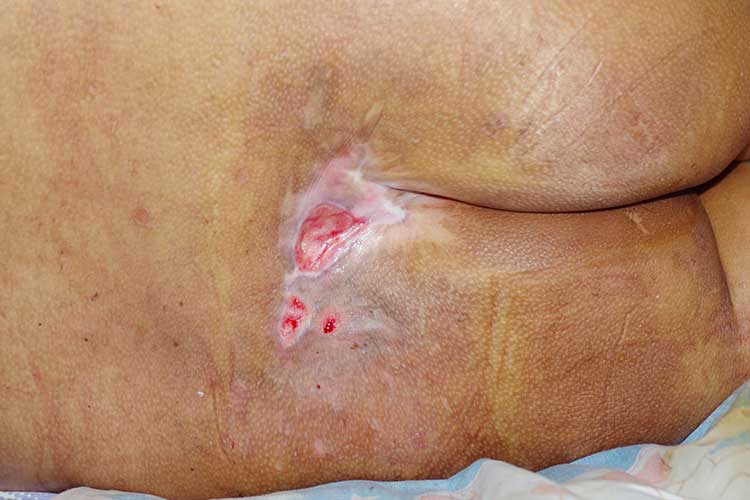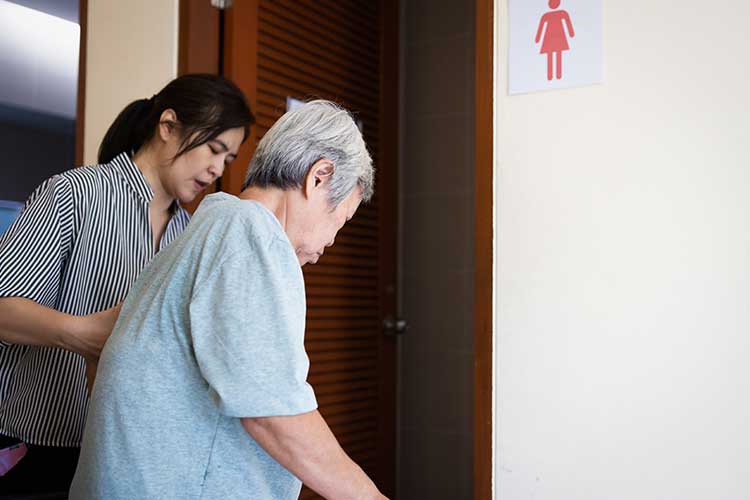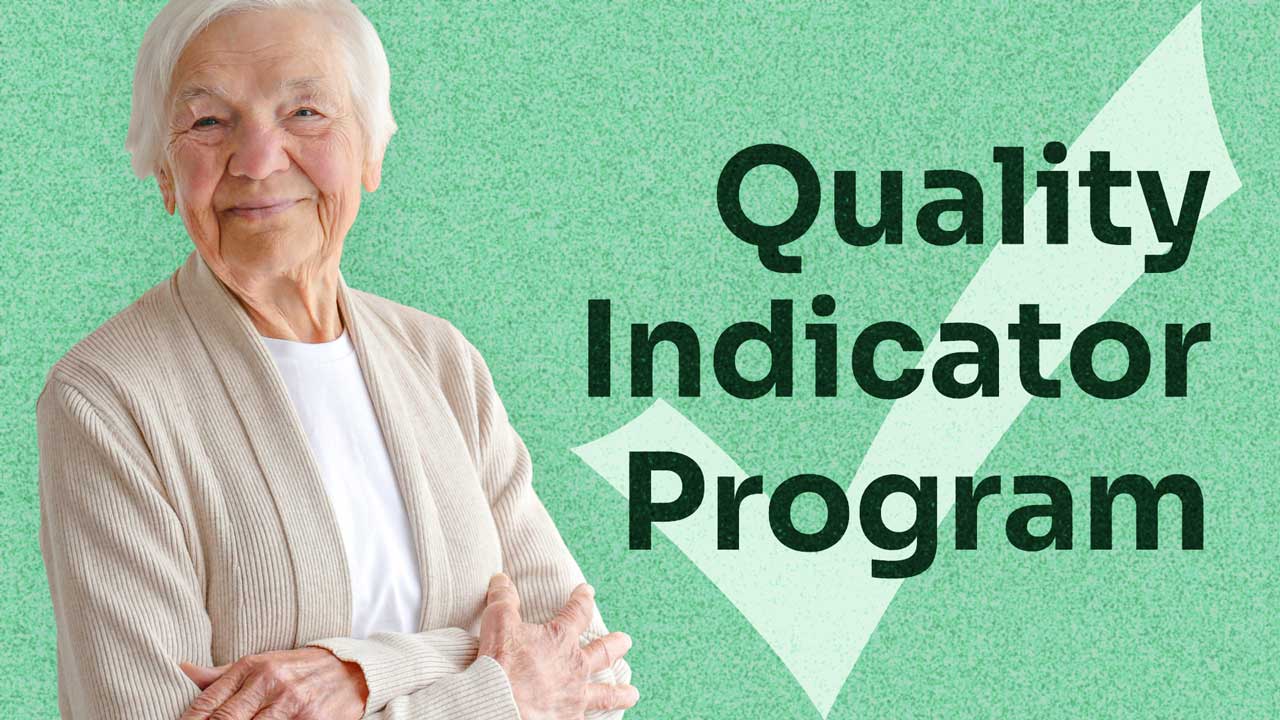What is the National Aged Care Mandatory Quality Indicator Program?
The National Aged Care Mandatory Quality Indicator Program (QI Program), which was introduced on 1 July 2019, requires Commonwealth-subsidised residential aged care services to collect data and report on specific areas of care that older adults have identified as being most important to them (DoHaAC 2023).
Providers must report their performance across each of these quality indicators every three months in order to measure the quality and safety of their services and facilitate continuous improvement (DoHaAC 2023).
This data is made available publically to help older adults and their families assess the quality of different services and make decisions about their care (DoHaAC 2025).
What are the Quality Indicators?
There are 11 quality indicators that providers must submit data on. These are:
- Pressure injuries
- Physical restraint
- Unplanned weight loss
- Falls and major injury
- Medication management
- Activities of daily living
- Incontinence care
- Hospitalisation
- Workforce
- Consumer experience
- Quality of life.
(DoHaAC 2025)
1. Pressure Injuries

A pressure injury is defined as ‘a localised injury to the skin and/or underlying tissue, usually over a bony prominence, as a result of pressure, shear, or a combination of these factors’.
This quality indicator requires each resident to be assessed for pressure injuries using the ICD-10-Australian Modified (AM) pressure injury classification system, which outlines six stages of pressure injury:
- Stage 1 pressure injury
- Stage 2 pressure injury
- Stage 3 pressure injury
- Stage 4 pressure injury
- Unstageable pressure injury
- Suspected deep tissue injury.
All residents must be assessed every quarter, except for:
- Residents who declined to give consent to undergo a pressure injury assessment for the entire quarter
- Residents who were absent for the entire quarter.
What Data Needs to be Collected?
- The number of residents assessed for pressure injuries
- The number of residents excluded because they declined to give consent to undergo a pressure injury assessment for the entire quarter
- The number of residents excluded because they were absent for the entire quarter
- The number of residents with one or more pressure injuries, categorised into each of the six pressure injury stages
- The number of residents who acquired one or more pressure injuries outside of the service during the quarter
- The number of residents who acquired one or more pressure injuries outside of the service during the quarter, categorised into each of the six pressure injury stages.
Note: If a resident has more than one pressure injury, all pressure injuries must be assessed and their stage recorded.
(DoHaAC 2023)
2. Physical Restraint

Under the QI program, the term physical restraint is used as an umbrella term for all types of restrictive practices, except for chemical restraint. This includes:
- Mechanical restraint
- Physical restraint
- Environmental restraint (including restraint through the use of a secure area)
- Seclusion.
Physical restraint is measured over a single three-day assessment period each quarter, which includes a designated collection date in addition to the two days prior to the collection date. This collection date must be varied and unpredictable for staff.
All residents must be assessed every quarter, except for residents who were absent for the entire three-day assessment period.
What Data Needs to be Collected?
- The collection date for the quarter
- The number of residents whose records were assessed for pressure injuries during the three-day assessment period
- The number of residents excluded because they were absent for the entire three-day assessment period
- The number of residents who were physically restrained one or more times during the three-day assessment period
- The number of residents who were physically restrained during the three-day assessment period exclusively through the use of a secure area.
(DoHaAC 2023)
3. Unplanned Weight Loss

Read: Unplanned Weight Loss in Aged Care
The QI program outlines two categories of unplanned weight loss:
- Significant unplanned weight loss, where a person loses greater than or equal to 5% of their body weight within three months. This is measured by weighing the resident in the last month of the quarter and comparing this with their weight from the last month of the previous quarter.
- Consecutive unplanned weight loss, where a person loses any amount of weight every month for three months in a row. This is measured by weighing the resident three times (once each month) over the quarter.
All residents must be assessed for both types of unplanned weight loss every quarter, except for:
- Residents who declined to give consent to be weighed
- Residents receiving end-of-life care
- Residents who did not have the required weights recorded.
What Data Needs to be Collected?
Significant unplanned weight loss:
- The number of residents assessed for significant unplanned weight loss
- The number of residents excluded because they declined to give consent to be weighed on the collection date
- The number of residents excluded because they are receiving end-of-life care
- The number of residents excluded because they did not have the required weights recorded (the provider must give an explanation as to why this is the case)
- The number of residents who experienced significant unplanned weight loss.
Consecutive unplanned weight loss:
- The number of residents assessed for consecutive unplanned weight loss
- The number of residents excluded because they declined to give consent to be weighed on any of the collection dates
- The number of residents excluded because they are receiving end-of-life care
- The number of residents excluded because they did not have the required weights recorded (the provider must give an explanation as to why this is the case)
- The number of residents who experienced consecutive unplanned weight loss.
(DoHaAC 2023)
4. Falls and Major Injury

The QI program defines a fall as ‘an event that results in a person coming to rest inadvertently on the ground or floor or other lower level’.
A fall resulting in major injury describes a fall that meets the above criteria and results in at least one of the following:
- Bone fracture
- Joint dislocation
- Closed head injuries with an altered state of consciousness
- Subdural haematoma.
All residents must be assessed every quarter, except for residents who were absent for the entire quarter.
What Data Needs to be Collected?
- The number of residents whose records were assessed for falls and major injury
- The number of residents excluded because they were absent for the entire quarter
- The number of residents who experienced one or more falls at the care service during the quarter
- The number of residents who experienced one or more falls at the care service that resulted in major injury during the quarter.
(DoHaAC 2023)
5. Medication Management

Read: The Aged Care Quality Indicator Program: Medication Management (Polypharmacy and Antipsychotics)
The QI program requires providers to report on both:
- Polypharmacy, which is defined as the prescription of nine or more medicines to a single care recipient. This must be recorded on a single collection date each quarter.
- The use of antipsychotics. This must be measured over a designated seven-day assessment period each quarter, which includes a designated collection date in addition to the six days prior to the collection date. This collection date must be varied and unpredictable for staff.
All residents must be assessed every quarter, except for residents who were in hospital during the respective collection periods.
What Data Needs to be Collected?
Polypharmacy:
- The collection date for the quarter
- The number of residents assessed for polypharmacy
- The number of residents excluded because they were in hospital on the collection date
- The number of residents prescribed nine or more medications (based on their medication charts and/or administration records).
Antipsychotics:
- The collection date for the quarter
- The number of residents assessed for antipsychotic medications
- The number of residents excluded because they were in hospital for the entire seven-day assessment period
- The number of residents who were given an antipsychotic medication
- The number of residents who were given an antipsychotic medication for diagnosed psychosis.
(DoHaAC 2023)
6. Activities of Daily Living

The term activities of daily living (ADLs) refers to an individual’s ability to perform basic life skills integral to independence and quality of life. These include eating, ambulating, toileting, dressing and personal hygiene.
This quality indicator requires each resident to be assessed for ADLs using the Barthel Index of Activities of Daily Living. This assessment should take place around roughly the same time every quarter.
All residents must be assessed every quarter, except for:
- Residents receiving end-of-life care
- Residents who were absent for the entire quarter
- Residents who did not have an ADL score recorded last quarter.
What Data Needs to be Collected?
- The number of residents assessed for ADL function
- The number of residents excluded because they are receiving end-of-life care
- The number of residents excluded because they were absent for the entire quarter
- The number of residents excluded because they did not undergo an ADL assessment in the previous quarter - this needs to include comments explaining why this data was not taken
- The number of residents with a total ADL score of zero in the last quarter
- The number of residents who have experienced a decline in ADLs (a decrease of one or more points from their total score last quarter).
(DoHaAC 2023)
7. Incontinence Care

Incontinence refers to loss of control over the bladder and/or bowels. Under the QI Program, a resident is considered to be incontinent if they:
- Experience bladder incontinence more than once per day, and/or bowel incontinence more than once per week, or
- Require a urinary catheter to pass urine.
This quality indicator requires each resident to be assessed for incontinence at roughly the same time every quarter. Those who are deemed to have incontinence must then be assessed for incontinence associated dermatitis (IAD) using the Ghent Global IAD Categorisation Tool.
The Ghent Global IAD Categorisation Tool sorts IAD into one of four sub-categories:
- 1A: Persistent redness without clinical signs of infection
- 1B: Persistent redness with clinical signs of infection
- 2A: Skin loss without clinical signs of infection
- 2B: Skin loss with clinical signs of infection.
All residents with incontinence must be assessed every quarter, except for residents who were absent for the entire quarter.
What Data Needs to be Collected?
- The number of residents assessed for incontinence care
- The number of residents excluded because they were absent for the entire quarter
- The number of residents excluded because they were not experiencing incontinence
- The number of residents with incontinence
- The number of residents with incontience who experienced IAD
- The number of residents with incontience who experienced IAD, categorised into each of the four IAD sub-categories.
(DoHaAC 2023)
8. Hospitalisation

This quality indicator requires providers to report on how many residents presented to the emergency department one or more times during the quarter. This should be assessed by undertaking a review of each resident’s care records for the quarter.
The QI Program defines an emergency department presentation as a resident presenting to an emergency department or urgent care centre in person or virtually.
A hospitalisation is defined as a resident being admitted into a hospital inpatient speciality service for ongoing management. This includes both planned and unplanned admissions, stays of any length and hospitalisations in any location (including hospital in the home).
All residents must be assessed every quarter, except for residents who were absent for the entire quarter.
What Data Needs to be Collected?
- The number of residents assessed for hospitalisation
- The number of residents excluded because they were absent for the entire quarter
- The number of residents who presented to the emergency department one or more times during the quarter
- The number of residents who presented to the emergency department or were hospitalised one or more times during the quarter.
(DoHaAC 2023)
9. Workforce

This quality indicator requires providers to report on their workforce. This should be assessed by undertaking a review of staff records every quarter.
What Data Needs to be Collected?
For definitions of each of the following staff member types, see the National Aged Care Mandatory Quality Indicator Program (QI Program) Manual 3.0 – Part A.
- The number of staff who worked as service managers for any hours in the previous quarter
- The number of staff who worked as nurse practitioners or registered nurses for any hours in the previous quarter
- The number of staff who worked as enrolled nurses for any hours in the previous quarter
- The number of staff who worked as personal care staff or assistants in nursing for any hours in the previous quarter
- The number of staff employed as service managers at the start of the quarter
- The number of staff employed as nurse practitioners or registered nurses at the start of the quarter
- The number of staff employed as enrolled nurses at the start of the quarter
- The number of staff employed as personal care staff or assistants in nursing at the start of the quarter
- The number of staff employed as service managers who stopped working during the quarter
- The number of staff employed as nurse practitioners or registered nurses who stopped working during the quarter
- The number of staff employed as enrolled nurses who stopped working during the quarter
- The number of staff employed as personal care staff or assistants in nursing who stopped working during the quarter.
Note:
- Employed means the staff member worked for at least 120 hours in the previous quarter.
- Staff who stopped working during the quarter are those who have not worked at the service for a period of at least 60 consecutive days during the current quarter.
(DoHaAC 2023)
10. Consumer Experience

This quality indicator requires providers measure consumer experience. This should be assessed by giving every resident the opportunity to complete the Quality of Care Experience Aged Care Consumers (QCE-ACC) tool, which asks residents to report on six key areas of the quality of care experience:
- Respect and dignity
- Supported decision-making
- Skills of aged care staff
- Impact on health and wellbeing
- Social relationships and community connection
- Confidence in lodging complaints.
The QCE-ACC should be given to residents at roughly the same time every quarter.
Exclusions include:
- Residents who were absent for the entire quarter
- Residents who chose not to complete the QCE-ACC for the quarter.
What Data Needs to be Collected?
- The number of residents offered the QCE-ACC through self-completion, interviewer facilitated completion or proxy-completion
- The number of residents excluded because they were absent for the entire quarter
- The number of residents excluded because they chose not to complete the QCE-ACC for the quarter
- The number of residents who completed the QCE-ACC through each completion method (self-completion, interviewer facilitated completion and proxy-completion), scored against the following five categories:
- Excellent: Those who scored between 22 and 24
- Good: Those who scored between 19 and 21
- Moderate: Those who scored between 14 and 18
- Poor: Those who scored between 8 and 13
- Very poor: Those who scored between 0 and 7.
(DoHaAC 2023)
11. Quality of Life

Quality of life is an individual’s perception of their position in life. It encompasses their environment, goals, expectations, standards and concerns, and their emotional, physical, material and social wellbeing.
This quality indicator requires providers measure residents’ quality of life. This should be assessed by giving every resident the opportunity to complete the Quality of Life Aged Care Consumers (QOL-ACC) tool, which asks residents to report on six key areas of quality of life:
- Independence
- Mobility
- Pain management
- Emotional wellbeing
- Social relationships
- Leisure activities and hobbies.
The QCE-ACC should be given to residents at roughly the same time every quarter.
Exclusions include:
- Residents who were absent for the entire quarter
- Residents who chose not to complete the QOL-ACC for the quarter.
What Data Needs to be Collected?
- The number of residents offered the QOL-ACC through self-completion, interviewer facilitated completion or proxy-completion
- The number of residents excluded because they were absent for the entire quarter
- The number of residents excluded because they chose not to complete the QOL-ACC for the quarter
- The number of residents who completed the QCE-ACC through each completion method (self-completion, interviewer facilitated completion and proxy-completion), scored against the following five categories:
- Excellent: Those who scored between 22 and 24
- Good: Those who scored between 19 and 21
- Moderate: Those who scored between 14 and 18
- Poor: Those who scored between 8 and 13
- Very poor: Those who scored between 0 and 7.
(DoHaAC 2023)
How to Report Data
Quality indicator data must be submitted through the My Aged Care service and support portal.
The Department of Health and Aged Care has made QI Program data recording templates available to assist in calculating and summarising data for each quality indicator.
Test Your Knowledge
Question 1 of 3
Which one of the following is not one of the 11 mandatory quality indicators?
Topics
Further your knowledge
 Free
Free Free
FreeReferences
- Department of Health and Aged Care 2023, National Aged Care Mandatory Quality Indicator Program (QI Program) Manual 3.0 – Part A, Australian Government, viewed 27 March 2025, https://www.health.gov.au/resources/publications/national-aged-care-mandatory-quality-indicator-program-manual-30-part-a?language=en
- Department of Health and Aged Care 2025, About the QI Program, Australian Government, viewed 27 March 2025, https://www.health.gov.au/our-work/qi-program/about
 New
New 
